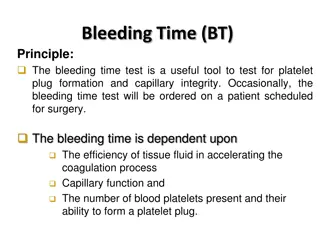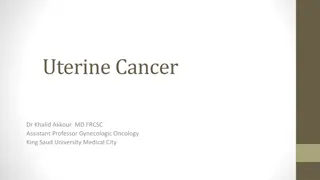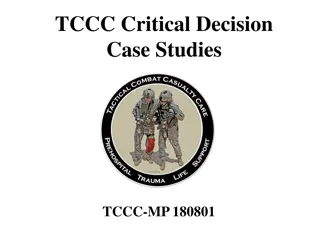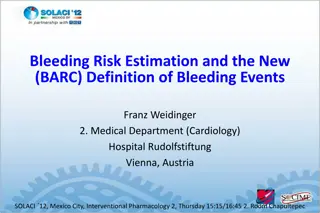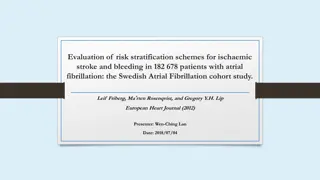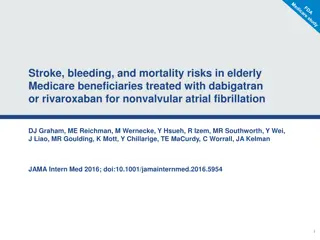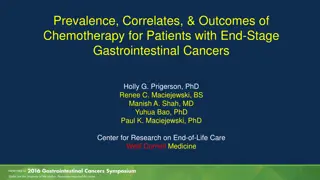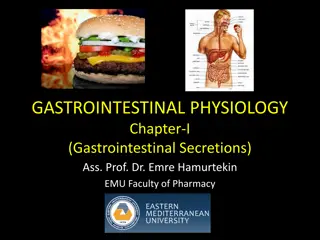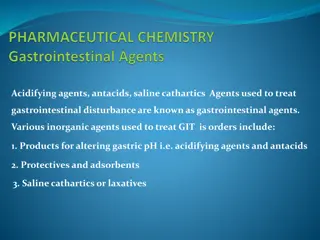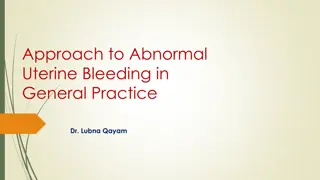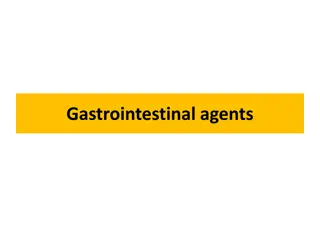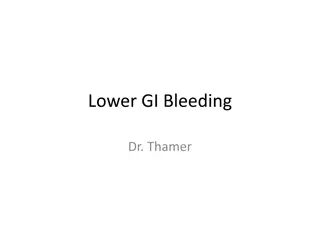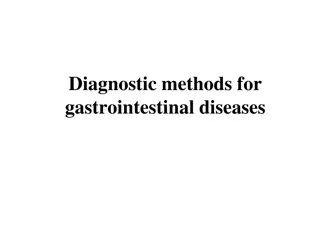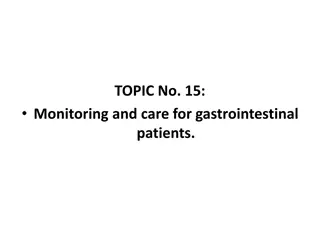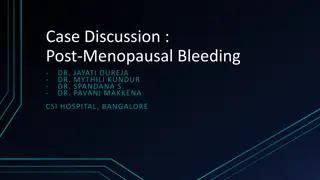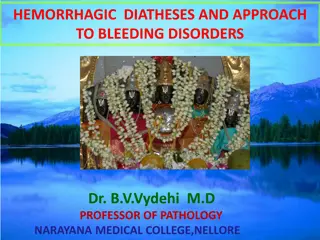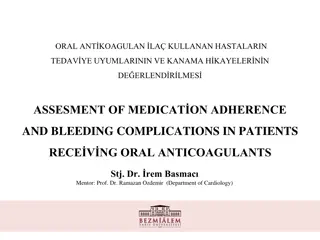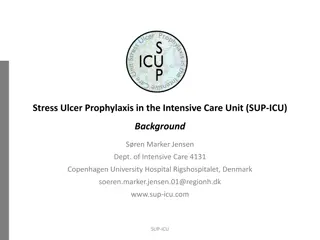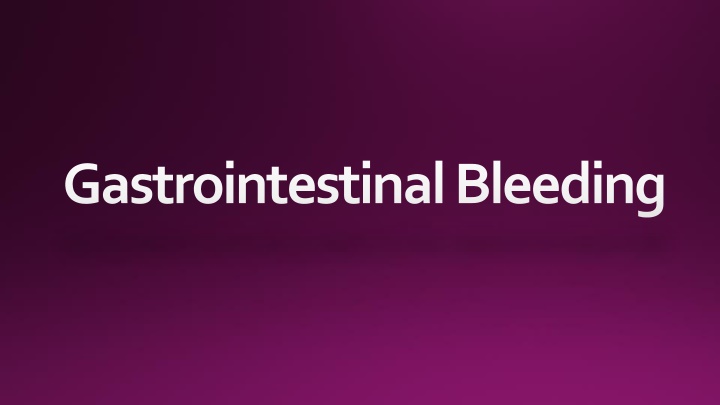
Understanding Gastrointestinal Bleeding: Symptoms, Management, and Mortality Rates
Learn about acute gastrointestinal bleeding, its symptoms like hematemesis and melena, evaluation goals, common causes, differential diagnosis, and the reliability of shock indicators in assessing bleeding severity. Explore the importance of prompt recognition, treatment, and the estimated inpatient mortality rates for upper and lower GI bleeding cases.
Download Presentation

Please find below an Image/Link to download the presentation.
The content on the website is provided AS IS for your information and personal use only. It may not be sold, licensed, or shared on other websites without obtaining consent from the author. If you encounter any issues during the download, it is possible that the publisher has removed the file from their server.
You are allowed to download the files provided on this website for personal or commercial use, subject to the condition that they are used lawfully. All files are the property of their respective owners.
The content on the website is provided AS IS for your information and personal use only. It may not be sold, licensed, or shared on other websites without obtaining consent from the author.
E N D
Presentation Transcript
Hojat Vahedi, MD Associate professor of Emergency Medicine TUMS, Shariati hospital
Acute gastrointestinal (GI) bleeding is a potentially life-threatening condition that requires prompt recognition and treatment. Upper GI bleeding (UGIB) usually presents as: hematemesis (blood or coffee-ground emesis) melena (black, tarry stool). Lower GI bleeding (LGIB) most frequently presents as: hematochezia (frank blood per rectum) red or maroon-colored stool
The goals for evaluation and management to stabilize the patient confirm that the gut is the origin of the bleeding determine the likely site and nature of the bleeding Provide appropriate therapy.
Inpatient mortality from UGIB and LGIB is estimated to be 10% and 4%
Common Causes of Gastrointestinal Bleeding in Adults and Children
Differential Diagnosis Patients presenting with an apparent GI bleed should be evaluated for non-GI sources. Epistaxis can mimic or cause hematemesis vaginal bleeding can be mistaken for hematochezia. Some foods (e.g., beets) and medications (e.g., cefdinir) can discolor stools to appear red and bismuth (e.g., in Pepto-Bismol), or iron use can turn the stool black.
Symptoms UGIB usually presents as hematemesis (either bright red blood or coffee-ground emesis) or melena LGIB generally presents with hematochezia but can present with melena if the origin is proximal in the small bowel The character of stools is not entirely specifc to the location of the hemorrhage. small bowel or colonic bleeding with slow transit times can present with melena. Hematochezia is not limited to LGIB. It can be seen with a brisk UGIB, and upper GI origin should be considered in a hemodynamically unstable patient with hematochezia.
Indicators of shock are more reliable as a gauge of bleeding severity than is the color of the emesis
Epigastric pain may indicate PUD. Hematemesis that occurs afer vomiting or retching is seen with esophageal tears. Unexplained weight loss is suggestive of malignancy. Constipation or painful bowel movements may precede bleeding from hemorrhoids or an anal fssure, respectively.
Symptoms indicative of cerebral hypoperfusion, such as lightheadedness, are predictive of more severe hemorrhage Susceptible patients with signifcantblood loss may develop acute coronary syndrome (ACS) Patients with signifcantblood loss should be queried for a history of coronary disease, but typical symptoms of ACS, such as chest pain or shortness of breath, may not be present in UGIB patients
Signs Patients with acute GI bleeding should be assessed for signs of shock, which increases risk for death. Tachycardia and hypotension are predictive of a severe bleed. A shock index (heart rate divided by systolic blood pressure) can be used to guide resuscitation
On physical examination, patients with PUD or severe gastritis may have tenderness in the lefupper quadrant. The presence of ascites may indicate portal hypertension, increasing the likelihood of esophageal varices. In such cases, rectal examination may identify varices or dense collateral veins around the anus and rectum.
Diffuse abdominal tenderness may indicate GI perforation or bowel ischemia. A digital rectal exam can help in elucidating the type or severity of bleeding Hemorrhoids or anal fssures may be apparent on rectal exam.
Laboratory Testing focused on risk stratification Patients with hemodynamic instability require rapid resuscitation before laboratory results become available. An initial lactatelevel greater than 2.5 mmol/L is associated with the development of inhospitalhypotension and increased 30-day mortality. An initial international normalized ratio (INR) greater than 1.5 or a hemoglobinless than 10 g/dLis predictive of increased inpatient mortality and the need for intensive care unit (ICU) admission.
Isolated azotemia is ofenseen in patients with UGIB A blood urea nitrogen to creatinine (BUN:Cr) ratio higher than 35 is 90% specifcin identifying UGIB. BUN:Cr ratio is poorly sensitive and not useful in excluding an UGIB. Blood is typed and screened for stable patients and crossmatchedfor unstable patients. Use uncrossmatchedblood product transfusion for patients with ongoing brisk hemorrhage requiring rapid resuscitation
Electrocardiogram screening electrocardiogram (ECG): patients older than the age of 35 years those with cardiac risk factors. A history of diabetes, tobacco use, liver cirrhosis, anemia (hemoglobin <9 g/dL), or prior episodes of ACS are risk factors
Nasogastric Aspirate Testing We do not recommend the routine placement of a nasogastric tube (NGT) The procedure is both uncomfortable and potentially time- consuming NGT lavage performed before endoscopy should be left to the endoscopistand performed as part of that procedure.
Imaging Bedside ultrasound can confrm the presence of ascites, increasing the likelihood that esophageal varices are the cause of UGIB. The American College of Radiology (ACR) Appropriateness Criteria state that endoscopy is preferred before radiologic imaging for patients with signifcantUGIB
The ACR recommends angiography as an appropriate alternative in unstable patients with suspected LGIB, because this modality can potentially be used to both localize and embolizebleeding sources.
CTA is capable of detecting bleeding as slow as 0.3 mL/min. It is useful if endoscopic localization of the hemorrhage is not possible or unsuccessful. CTA should be considered, in consultation with gastroenterology, for stable patients with LGIB to assist in identifying the hemorrhage location
CTA is not optimal in hemodynamically unstable patients with suspected LGIB, because it may delay management. Immediate conventional angiography (with potential embolization) is the preferable strategy for these patients.
Concerning history includes: Estimated blood loss >500 mL as suggested by symptoms of hypovolemia: dizziness, lightheadedness, syncope, confusion, and weakness History of previous abdominal vascular surgeries Use of anti-coagulants Initial lactate >4 Hemoglobin <10 or decrease >1 from baseline
MANAGEMENT I. prompt resuscitation II. consideration of blood or platelet transfusion III. pharmacologic therapy IV. early consultation with gastroenterology, interventional radiology, or surgery For patients with massive UGIB, early attention to airway protection and intubation
Resuscitation All patients who present with an acute GI bleed have a minimum of two large bore IV catheters placed. Patients with signs of impending hemodynamic compromise (tachycardia, hypotension, diminished mental status) should have crystalloid fluids rapidly infused, with a goal of delivering 2 L over the frst30 minutes. patients with a massive bleed (active hematemesis or hematochezia with a shock index >0.9) should receive an immediate transfusion of PRBCs
Patients with massive UGIB with uncontrollable hematemesis, respiratory distress, or severe shock limiting their ability to protect the airway or cooperate with treatment should be intubated early in their resuscitative course, unless they respond rapidly to treatment
Blood Product Transfusion stable patients with an UGIB without known coronary artery disease (CAD) should receive transfusion of red blood cells to restore their hemoglobin to at least 8 g/dL A higher hemoglobin target is appropriate for patients with known CAD who are at increased risk of adverse outcomes from anemia. transfusion to a minimum hemoglobin greater than 9 g/dL for patients with known or symptomatic CAD or to the level necessary to resolve cardiac ischemia
For patients with suspected portal hypertension overtransfusion may worsen portal hypertension and increase bleeding
Maintaining a platelet count of greater than 50,000 platelets/L. Empiric platelet transfusion for patients on antiplatelet medications who are not thrombocytopenic is unlikely to be of benefit and therefore not recommended.
In patients requiring massive transfusion (more than 4 units of PRBCs), we recommend a balanced transfusion approach of 1:1:1 PRBC:platelets:FFP The administration of FFP and PCC may increase the rate of thrombotic events, so their routine use in patients with liver failure and acute GI bleeding is not recommended unless receiving massive transfusion.
known benefits of early endoscopy for acute UGIB, endoscopy should generally not be postponed while awaiting correction of coagulopathy
INR, PT, and PTT have less of a role in the management of GI bleeding in patients on direct oral anticoagulants such as dabigatran or factor Xa inhibitors (apixaban, rivaroxaban, edoxaban). Reversal agents may be used in unstable patients. Idarucizumab can be utilized to reverse dabigatran. PCC or coagulation factor Xa [recombinant], inactivated-zhzo may be used to reverse factor Xa inhibitors
Pharmacologic Therapy treatment with a high-dose, continuous PPI infusion has been shown to decrease rebleeding, surgery, and mortality in patients with bleeding ulcers a single dose of IV omeprazole 80 mg as a cost-effective and less time- consuming treatment option. This is followed by subsequent doses of 40 mg every 12 hours
Splanchnic vasoconstrictors such as somatostatinand octreotide reduce portal hypertension and decrease risks of bleeding and transfusion requirements in patients with varicealbleeding. octreotide 50 gIV bolus (or an equivalent agent), followed by 50 g/h continuous infusion for patients with acute UGIB and known liver disease, varicealbleeding, alcoholism, or abnormal liver function tests There is no rationale for the routine administration of these agents in patients with presumed nonvaricealbleeding.
Prokinetic agents such as erythromycin administered prior to endoscopy improve visualization, limit the need for repeat esophagogastroduodenoscopy (EGD), decrease blood transfusion requirements, and decrease hospital length of stay for patients with severe or active UGIB. For patients going directly for EGD from the ED, a single dose of erythromycin 250 mg IV should be administered 30to120 minutes prior to EGD.
Tranexamic acid is an antifbrinolytic agent that improves outcomes in the settings of postpartum hemorrhage and trauma. Tere are currently insufcient clinical data to recommend the use of tranexamic acid in patients with GI bleeding
For the specific subset of patients with UGIB and known or suspected cirrhosis, antibiotic prophylaxis is recommended. Antibiotics reduce the rate of bacterial infection and mortality. Fluoroquinolones (e.g., ciprofloxacin 400 mg IV) or a third- generation cephalosporin (e.g., cefriaxone 1 to 2 g IV) are appropriate prophylactic antibiotics
Balloon Tamponade For rapidly exsanguinating patients with a presumed variceal bleed, the placement of a balloon tamponade device is indicated when endoscopy is not promptly available. Commercially available devices include the Sengstaken-Blakemore tube and the Minnesota tube. significant complications only as a temporizing measure for patients with ongoing, life- threatening bleeding.
Definitive Treatment Early consultation. For patients with a brisk LGIB, emergent consultation with an interventional radiologist for possible selective embolization. also simultaneous consultation with surgery. If a source of bleeding is not readily identifedwith CTA, unstable patients with brisk LGIB may require urgent surgical intervention
THANK YOU FOR YOUR ATTENTION

